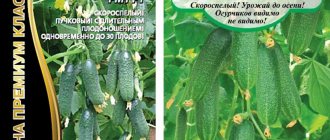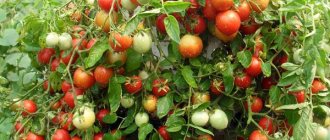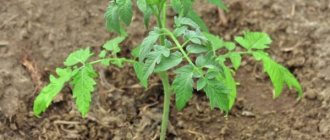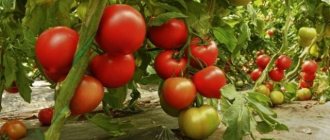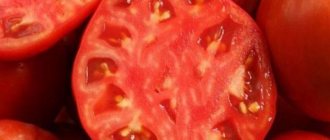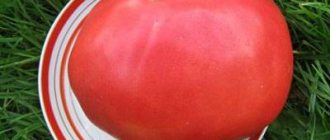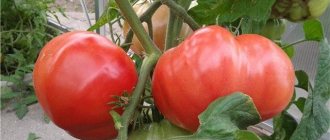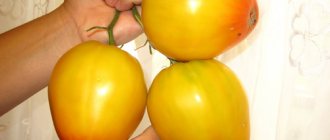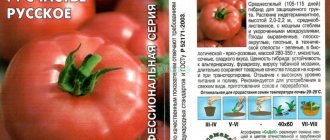Vegetable growing » Tomatoes
1
1775
Article rating
Kira Stoletova
There are various varieties of tomatoes. Some produce a good harvest when grown in greenhouses and greenhouses. Others are suitable for open ground. One of the most popular street varieties is the Linda tomato.
Description of Linda tomatoes
Tomatoes of this variety are tasty and sweet. They are perfect for fresh consumption, as well as for preparing various dishes or for pickling. The main thing is to know about the features of obtaining a good harvest.
Characteristics and description of the Linda tomato variety
Tomato Linda f1 is optimal for people who do not have the time or desire to tend to their beds. This is due to the fact that no more than ten bushes can be planted on one square meter. Of course, this variety is not suitable for large-scale cultivation, since this will require quite large plots of land. But before making a decision, you need to study the description of the variety.
Features of the variety
Plants of this variety are unpretentious and can grow over a long period. At the same time, the fruits ripen quite quickly. So, if you sow tomato seeds at the end of spring, then in mid-summer you can already harvest the first harvest from the bush.
Linda tomato is a low-growing dwarf plant, the height of which does not exceed 30 cm. The bush has compact dimensions and a dense stem. There is relatively little foliage. A characteristic feature of this variety is that the dense fruits are placed in a bunch. They have a round shape and easily tolerate temperature changes. They are also unpretentious to lighting. But it is worth noting that if there is enough light, much more ovaries will form on the bush.
An adult plant is a small bush, which is dotted with small tomatoes. The average weight of the fruit is approximately 30 grams. You can collect them until the end of September. The fruits are universal and can be used to prepare various salads. They are also suitable for pickling and canning.
I grew tomatoes of the Linda variety on balconies in pots or boxes. They are not afraid of unprotected ground. This characteristic explains the popularity of tomatoes among the population.
Advantages and disadvantages
Among the advantages of this variety it is worth highlighting:
- unpretentiousness in cultivation and care;
- good yield;
- the ability to grow in a limited space, which is accessible due to the small size of the bush;
- good taste, which allows the fruits to be used for preparing various dishes;
- are not exposed to many diseases and can easily tolerate a drop in temperature;
As for the disadvantages, at the moment there are no such noted, as indicated by consumer reviews.
How to sow correctly
Linda tomato is best sown in neutral, fertile and well-drained soil. The growing technology looks something like this:
Soak the seeds in a special solution that stimulates their germination. After some time, they are laid out on a plate and covered with a damp cloth. In a few days they will have small roots. This means that the seeds can be sown in the soil. It's a pretty easy process. Tomato seeds are simply laid out and covered with a layer of soil, the thickness of which should not exceed 1 cm. The container or bed is covered with plastic wrap until the first tomato shoots appear. After that it is removed
When it comes to growing tomatoes in boxes, special attention is paid to temperature conditions. Throughout the entire growth period, seedlings need to be fed with mineral fertilizers. After planting, fertilizing is carried out once every six months.
How to care after planting
Tomatoes love heat very much. Therefore, I planted them on the east or south side. If the plant suddenly begins to stretch upward sharply, and internodes have formed between the leaves, then this indicates that it is hot.
If Linda tomatoes are grown on a balcony or in a greenhouse, then you need to carefully monitor the temperature. This is especially true in the summer when it is hot outside. If necessary, the temperature is lowered by ventilation or by limiting the access of sunlight to the enclosed space.
Linda tomatoes will need to be dusted with your own hands. To do this, use a soft, small brush. It is worth noting here that the plant does not need to be tied up. During the flowering period, it is necessary to fertilize with mineral fertilizers. Also, to solve this problem, use ordinary ash diluted with water.
Ripening time and yield
The first fruits are harvested around mid-June. If the seeds were planted in March, after about 100 days, summer residents try their tomatoes. Linda F1 bears fruit until late autumn. It is noted that the more often the fruits are removed from the bush, the more fruit it bears.
Productivity reaches 2 kg per bush. Fans also point out that all the fruits of this plant turn red quickly and at the same time, so some gardeners treat the bushes with a magnesium solution so that they do not turn red longer.
The best time to harvest is early in the morning. First, remove the ripe tomatoes. For long-term storage and sale, it is recommended to remove brown tomatoes; they will ripen on their own in a dark place.
The variety "Linda" gives an excellent harvest. About 3 kg of miniature fruits are collected from the bush.
In open ground, tomatoes of the review variety can be planted in the southern regions of the country. At home, Linda cherry tomatoes are grown in all regions of Russia - on window sills, heated balconies, loggias and terraces.
Features of cultivation
The ideal place for growing is open ground. Tomatoes will also be comfortable in greenhouses, and the bushes will produce a good harvest. Gardeners usually plant 4 seedlings per 1 m². Young seedlings are planted after the end of frost. In warm regions, seeds are immediately sown in the ground without first growing seedlings.
Seed preparation
The preparation of seeds of this variety is similar to other types of tomatoes: exclude defective, empty and moldy seeds.
To improve growth, professionals recommend treating the seeds with growth stimulants and, to increase resistance to infections, disinfecting them with a solution of potassium permanganate in a ratio of 1 g per 1 liter of water. The seeds are kept in the solution for 20-30 minutes, after which they are washed with running water and placed in growth stimulants for 12 hours.
Planting seeds and care
The next stage after preparation is planting the seeds in seedling cups or boxes. The ideal soil is considered to be a mixture of turf soil, peat, black soil and a small amount of sand. Gravel is poured into the bottom of cups or boxes to serve as drainage. Expanded clay is also suitable here.
2 or 3 seeds are planted in cups, and one seed per 7 cm² in boxes. The plantings are covered with polyethylene and placed in a room with a temperature of at least 25°C. Water with a moderate drip method. Light is provided up to 12 hours a day. If there is not enough daylight, lamps are used.
When the seeds sprout, the plastic film is removed and the temperature is reduced to 20°C.
After the formation of 2-3 leaves, a pick is made. When the seedlings grow to 10-15 cm, they are planted in the ground.
How to care for a tomato after planting - general recommendations
Caring for tomatoes is easy. Main:
- Water regularly after sunset.
- Do not fill. Excessive moisture will lead to the death of the bush. Before the fruits appear, it is enough to water 1-2 times every two weeks.
- Feed the soil. You can plant plants between the rows that improve the composition of the soil - peas, clover, mustard.
- Weed and hill up the soil after planting.
- Tie up bushes. Although many gardeners say that the stems are strong enough and behave well without tying them up, professionals say that this must be done so that the plants do not break under the weight of the ripe crop.
- Protect from insect pests.
- To prevent diseases: spray with a solution of wood ash or nettle tincture.
Popular fertilizers
Despite the unpretentiousness of the variety, the soil needs to be fed 5 times per season with organic and mineral fertilizers:
- Before planting seedlings, gardeners fertilize the soil with manure and compost.
- 3 weeks after planting the seedlings, phosphorus, potassium and nitrogen or a solution of bird droppings are added to the soil.
- When the ovary is formed, the soil is fertilized with ready-made mineral fertilizer: “Ideal”, “Nitrophoska”, “Agricol-Vegeta”. Potassium chloride and sodium humate are also used.
- During the next feeding, when flowers form on the third cluster, mineral fertilizers are also used, including potassium sulfate and superphosphate.
- Gardeners carry out the last feeding 14 days after the previous one, mainly using superphosphate.
Bush care
After planting, the plants must be cared for as follows:
- Regularly water under the root with warm and settled water;
- Loosen the soil in the area with tomatoes;
- Weeding;
- Feed the bushes with organic matter and nutritional mineral complexes.
During the flowering period and 10-14 days after its completion, tomatoes can be fed with liquid mineral fertilizers containing phosphorus, nitrogen and potassium. Wood ash is also used as a top dressing, which is diluted in water in a ratio of 1 tablespoon per 500 ml.
Linda tomatoes do not require pinching or tying to supports.
Like all tomatoes, the review variety loves warmth and sunlight, so the bushes are best planted on the east or south side.
Since Linda F1 is a determinate hybrid, it does not require much space in the greenhouse, has many inflorescences, high yields and ripens quickly. You just need to provide proper care for this type of tomato.
Pruning of a determinate bush is mandatory. The first stepson must be combined with tying to a support, and the stepsons are removed before the first brush opens.
Stepchildren must be manually broken out before they reach 4-5 cm in length, since it is during this period that wounds in the sinuses can quickly heal. If the stepson has grown quite large and was not removed in time, then when removing it, leave the stump so that a large wound does not form on the stem, which can easily become infected.
Do not forget - any care for tomatoes should be done in dry weather, without watering or feeding them the day before.
It is more effective to form a tomato into one stem, and then, when it throws out 3-4 trusses, you should choose a strong stepson and continue to grow the bush with 2 stems. If you form a tomato into 2 stems at once, this will inhibit its growth in the early stages.
Determinate hybrids are also prone to pinching - growth begins to develop into an inflorescence, so it is necessary to remove the stepsons, but if you remove everything at once, the plant stops growing. Therefore, do not forget to leave a couple of backup stepsons, do not delete all the unnecessary ones at once.
Help the inflorescences pollinate, especially in hot weather. To do this, shake them with your hands and spray them with large drops of warm water (temperature no lower than 16°C).
As for watering the hybrid, it is watered moderately in the first 2 weeks. Otherwise, this will delay the appearance of fruits, and otherwise lead to fungal diseases of the bushes.
When the fruit cluster is ripe, the leaves under it are removed, but not too often - 2-3 leaves per week. Remember that on average there should be about 15 leaves on the bush to protect the plant from the heat.
Hand pollination
Description of the variety
Linda F1
A larger product of the labor of Japanese breeders, which prefers open soil. The bush can grow up to 80 cm, the stem is dense and powerful. Fruit formation occurs on average 100 days after planting. There is excellent resistance to fusarium and verticillium.
Features of the fruits of the tomato variety Linda f1:
- the size of the fruits of the hybrid varies over a fairly wide range, but on average the tomatoes are large and “fleshy”;
- The hybrid is characterized by a bright red color of both the skin and the pulp inside the tomato;
- since large fruits dominate on average, the average weight is also impressive - it can reach 300 grams;
- Large, richly flavored fruits are well suited for making juices and sauces, and are excellent for salads and other dishes.
Linda
The variety is distinguished by its high speed of fruit ripening, stability to slight temperature changes and excellent tolerance of poor lighting. The determinate bush is very compact in size - up to 30 cm in height, dense stem, not many leaves, large grouping of fruits.
It is important to know that the diseases verticillium and fusarium will not be an obstacle to an excellent harvest of this species, and the long period of fruiting will make it possible to collect fruits from mid-June to the end of September, which makes this species an excellent choice for the laziest connoisseurs of home seedlings. Features of the fruit:
Features of the fruit:
- small “Cherry” fruits, reminiscent of a bunch of grapes;
- ripe tomatoes turn out to be a rich, appetizing red color;
- The small size also means the modest weight of the tomato - up to 35 grams;
- small tomatoes are great for pickling, will be a successful choice for cutting into a salad, and will also be a wonderful edible decoration for any dish.
Planting and watering
Any planting region is suitable for growing Linda tomatoes. However, it must be borne in mind that a good harvest will only occur in closed ground conditions. This variety does not tolerate growing in open soil; many inflorescences simply dry out from excess ultraviolet radiation. This is explained by the fact that the bush itself has a small number of leaves and branches, so it does not have any protection for the root from sunlight.
The best option is to grow it on a balcony, loggia or directly on the windowsill. The conditions for indoor flowers are ideal for these tomatoes. At the same time, they can easily tolerate sudden changes in temperature, so they can be grown even in winter (but the yield will be low due to the short duration of daylight hours).
Seedlings are planted when they reach a height of about 12 centimeters. The seedlings turn out to be miniature, the roots are watered only slightly (literally 100 - 200 milliliters of water per bush). Seedlings should not be planted deep - the root system of these tomatoes is not extensive, most of it will be visible on the surface.
It is recommended to water frequently - about once every 3 days. But Linda tomatoes tolerate even severe drought well. Optimal planting scheme in a greenhouse:
- 6 bushes per linear meter;
- row spacing - up to 50 centimeters.
Tomato planting is done by seeds. Like any hybrid, “Linda F1” is an annual plant, so you should not plant seeds obtained from last year’s harvest, even a very good one.
Seed preparation for this variety is standard for this crop. It is necessary to exclude empty, defective and moldy seeds.
Preliminary disinfection of seeds and treatment of them with growth stimulants can improve their germination and increase resistance to infections of an adult plant. For disinfection, you can prepare a weak solution of potassium permanganate, taking it in the amount of 1 g per 1 liter of warm water. The seeds should be kept in this solution for 20-25 minutes, then rinsed under running water.
The next step is to place the seeds in special biostimulants for 12 hours. After this, they can be planted in boxes or special cups for seedlings. You can also pre-germinate the seeds by placing them in a warm and humid environment, and only then place them in the ground.
It is better to line the bottom layer of boxes or cups for seedlings with fine expanded clay or gravel, which will act as drainage. The soil is laid tightly and compacted a little to eliminate air pockets that are harmful to the seeds.
2-3 grains are planted per cup. First, grooves are made in the boxes at a distance of 7-10 cm from each other, after which the seeds are dropped into them in increments of 2-3 cm. Sprinkle with soil in a layer of no more than 1.5-2 cm.
Before and after sowing, it is necessary to moisten the soil. Then the containers are covered with plastic wrap and placed at a temperature of at least 25C. Seedlings need moderate watering, preferably by drip method.
It is important that there is at least 10-12 hours of daylight. This can be achieved using special lighting, which is installed above the tomatoes at a distance of 30 cm. It is recommended to turn on the lamps in the dark hours before dawn, as well as after sunset
On a rainy, gloomy day it is also better to use a lamp
It is recommended to turn on the lamps in the dark hours before dawn, as well as after sunset. On a rainy, gloomy day, it is also better to use a lamp.
After the seedlings peck, the film is removed and the air temperature drops to 18...20C. At the stage of formation of two or three leaves, a pick is made.
When the plants reach 10-15 cm in height, and weather conditions allow tomatoes to be planted in the ground, they are “relocated”. A week and a half before this event, the tomatoes are re-hardened by taking them outside, first for 15-20 minutes a day, then for 2-3 hours.
When planting tomatoes in the ground, you should be guided not so much by calendar values as by weather conditions. Bushes can be replanted only if there are no night frosts and the soil temperature is at least 15-18C.
Tomatoes love heat very much. Therefore, I planted them on the east or south side. If the plant suddenly begins to stretch upward sharply, and internodes have formed between the leaves, then this indicates that it is hot.
If Linda tomatoes are grown on a balcony or in a greenhouse, then you need to carefully monitor the temperature. This is especially true in the summer when it is hot outside. If necessary, the temperature is lowered by ventilation or by limiting the access of sunlight to the enclosed space.
Growing and care
Like many nightshades, the Linda tomato loves neutral, fertile, well-drained soil. Before sowing, it is advisable to soak the seeds in a solution of any biogrowth stimulant (Zircon, Epin, Energen, Vympel). At the seedling stage, seedlings are fed with complete mineral fertilizer, for example, “Kemira” or “Agricola” in solutions recommended class=”aligncenter” width=”400″ height=”400″[/img]
Read also: Grapes in Memory of Dombkowska: description of the variety, photos, reviews
Picked young plants should also receive the necessary nutrition throughout the entire growing season once every 2-3 weeks. The Linda tomato does not require pinching, support or tying, in fact confirming the assurances of the breeders that this variety will not become a burden for beginners and inexperienced gardeners.
Give me tips on growing tomatoes!…
Firsova
Tomatoes grown indoors are of the same varieties as in open ground, although you can also plant special “balcony” tomatoes, which are especially decorative. Seedlings grown for 40–45 days are planted in boxes in a permanent place. Mineral fertilizers are added to the boxes along with the soil. Water the tomato less often than the cucumber, but abundantly, after which the wet soil is sprinkled with a layer of dry soil.
Evgeniy Petrov
Well, let's start with the basics. First, the tomato needs sunlight or lighting. That is, now is not the best time for tomatoes. Secondly, you need to water less often, and in room conditions without ventilation, with excess moisture, fungal diseases, for example blackleg, can develop. Among the varieties I can recommend are Balcony Miracle, Little Red Riding Hood, Boni-M, Gavrosh. The best seeds are “Northern Seed Company”!
Larisa
Minibel indoor tomato 15 pcs. Minibel indoor tomato 15 pcs. characteristics: company: Varietal price: 15.00 Availability: yes ——————————————————————————– A low-growing plant with small tasty fruits, suitable for growing indoors conditions. A great kitchen decoration. Sowing: in March-April in seedling boxes. Lightly sprinkle the seeds. Shoots appear after 14 days at t = 20-25 oC. Seedlings should be planted after 3 weeks. Moisten the soil regularly. Good lighting is necessary. After 4 weeks, plant the plants in pots with a diameter of 12-15 cm. Care: water as needed. Regular feeding. To improve pollination, shake the stems. Flowering: fruits ripen in July-August. This tomato variety is proven and was grown in winter, but it needs lighting.
Tasha
It won't grow now. Plant at the end of February in new purchased land.
- Tomato varieties in open ground
- Diseases of tomato seedlings
- Planting tomatoes in a greenhouse
- Picking tomato seedlings
- Growing tomatoes in open ground
- Early tomatoes
- When to plant tomatoes in Siberia
- Growing tomato varieties
- Varieties of tomatoes for the balcony
- How long are tomato seeds soaked?
- What varieties of tomatoes are the most productive?
- Growing tomato seedlings
- Tomato seed treatment before sowing
- How often to water tomatoes in greenhouses
- How to plant tomato seedlings correctly
- Caterpillar on tomatoes
Tips and reviews from gardeners about Linda tomatoes
According to experienced gardeners, Linda tomatoes are an ideal option for growing crops in open ground. Care for such plants is minimal. Due to the powerful stem, the need for a garter rarely arises. The main thing is to organize moderate watering and not forget about fertilizing. Lovers of fresh vegetables will like these tomatoes. Already at the beginning of summer, you can be content with ripe fruits.
Fun competitions, games and riddles with answers for birthdays for children 9 - 12 years old
The main advantage of the variety's characteristics is the ability to choose a planting location (street or greenhouse). But it is also important to take into account the climatic features of the area. Those who have already encountered growing this variety know that evening cooling (especially critical in the northern regions of the country) often reduces tomato yields. Therefore, it is better to plant plants outside only in the southern regions. In the northern regions, they should be planted in greenhouses.
Hybrid Linda F1: description and characteristics
A product of Japanese selection, the Linda F1 tomato is a determinate-type bush with a powerful tuberous stem, reaching a height of 1 meter. Growing it in open ground is considered optimal. This is a medium-early large-fruited variety with fruit ripening on the 100-110th day from seed planting. The hybrid is characterized by a high yield of high-quality, uniform-sized fruits and retention of their size throughout the entire summer growing season. This property is responsible for the great popularity among vegetable growers of such crops as the Linda f1 tomato.
Description and reviews from professional gardeners emphasize the advantages of the hybrid:
- resistance to diseases such as Fusarium and Verticillium wilt, gray spot, Alternaria stem cancer;
- good adaptation to stressful growing conditions – cold snaps and rapid changes in weather conditions;
- ability for productive fruit set at high temperatures;
- excellent presentation of fruits, high transportability;
- dense skin of the fruit, allowing you to salt whole tomatoes.
The recommended planting density is 3-4 plants per square meter.
Tomatoes: advantages and disadvantages
The main advantages of the tomato hybrid “Linda” include:
- Good presentation of fruits;
- Excellent taste characteristics;
- Immunity to typical tomato diseases;
- High yield;
- Ability for long-term storage;
- Possibility of transportation over long distances;
- Easy to care for;
- Good tolerance to high temperatures;
- Large fruit;
- No tendency of fruits to crack;
- Long fruiting period;
- Possibility of growing on an industrial scale.
The disadvantages of a hybrid include:
- Relatively high cost of seed material;
- The need to purchase seed every year.
Comparative characteristics of tomato varieties Linda and Linda f1
Linda f1 is a hybrid that was bred by crossing the Linda tomato with early ripening varieties. Japanese breeders worked on obtaining this species.
Tomato Linda f1 is a mid-season, determinate, productive variety. Unlike the original form, it is suitable for growing in open ground and greenhouses. The ripening period is also not the same - for Linda f1 it is 100–110 days. The hydride bears fruit from late June to early September.
Another distinguishing feature is the size of the fruit. In the hybrid they are large, weighing 240–300 g, flat-round in shape, deep red in color. After ripening, there is no green spot left around the stalk. Due to its density, ripe vegetables do not crack. The total amount of sugar is 2.9–3.8%.
Compared to the original variety, the Linda f1 tomato bush is powerful and the stem is strong. This can be seen in the photo. The hybrid grows up to 80–100 cm in height. It can form 2–3 stems that need to be tied up. The leaves are green, medium in size. Inflorescences of intermediate type.
However, there are also common features of tomatoes: excellent taste, good adaptation to stressful situations, the appearance of ovaries even at high air temperatures.
Productivity
Two varieties of tomatoes have good fruiting rates. The yield of Linda tomato reaches 2–3 kg per square meter. m. At the same time, the planting pattern is dense - on one square. m of land you can plant 7–8 bushes.
The yield of marketable fruits of the Linda f1 variety is 2.2–3.2 kg/sq. m. Recommended planting density – 5 plants per square meter. m. These tomatoes are often grown commercially due to their attractive appearance, high yield and good transportability.
Area of application of fruits
Tomatoes Linda and Linda f1 have a rich taste. That’s why they are used for making homemade sauces, pickling, and canning whole fruits. Small cherry vegetables are suitable for fresh salads or as a decoration for main courses. Red fruits are used in industry to produce juices, ketchups and tomato pastes.
Resistance to diseases and pests
Tomato varieties Linda are highly resistant:
- to verticillium wilt;
- fusarium wilt;
- Alternaria stem cancer;
- gray leaf spot.
Has genetic protection against root-knot nematodes
Other insects also do not pay attention to the vegetable. The plant tolerates scorching sun, cold, and lack of lighting without loss of yield. Despite the fact that the culture is resistant to diseases, preventive measures to prevent them will not be superfluous
It is necessary to monitor the condition of the soil, do not flood it during watering.
Despite the fact that the culture is resistant to diseases, preventive measures to prevent them will not be superfluous. It is necessary to monitor the condition of the soil, do not flood it during watering.
Advantages and disadvantages of the variety
The hybrid variety Linda f1 is superior to the Linda variety in the following qualities:
- the possibility of planting tomatoes in greenhouses and open ground;
- harvesting in large quantities;
- transportability;
- weight and size of tomato.
Advantages of both varieties compared to other types of tomatoes:
- unpretentiousness when growing and caring for crops;
- excellent taste characteristics, high percentage of sugar content in tomato;
- easily tolerate temperature changes;
- are resistant to fungal diseases;
- fruiting occurs in the first summer month;
- compact size of bushes;
- high percentage of fruit yield;
- do not require pinching or tying;
- suitable for canning.
Among the disadvantages of the Linda tomato are: the inability to grow the crop in open ground conditions. Gardeners have not yet identified any negative aspects of Linda f1.
Harvesting
The harvest is harvested in the morning in warm weather, the dew drops on the fruit should dry. First, damaged and diseased tomatoes are taken away. It is allowed to collect not only red, but also brown/green fruits; They are sent to ripen in a dark place, sorted by size. The main thing is to have time to harvest before the onset of frost.
Did you know? Frequently picking ripe fruits speeds up the ripening of the rest.
Ripe tomatoes are stored in boxes, sprinkled with sawdust or sandwiched with paper.
Thus, Linda tomatoes, depending on the type, can be grown at home or in garden beds. The fruits are tasty, ripen quickly, have high disease resistance, and caring for them is no different from other types.
The more often you harvest, the faster the remaining fruits ripen. The first of them appear on the pagon after 7–8 leaves. The first tomatoes are up to 25 grams, the subsequent ones will be a little more. The smallest ones are the last ones, located closer to the upper leaves. You can speed up ripening by picking off a few of the weakest bunches.
The deadline for fruiting is 210 days from germination. It is better to store tomatoes in the refrigerator. In a cellar, the permissible storage period is 15 days. It is not recommended to pick fruits with green spots - they are unlikely to ripen, unlike other tomatoes (a feature of all cherry varieties).
Features of cultivation
Tomato variety Linda can be grown in several ways, depending on the climatic conditions in the planting region. In any case, the crop is planted in soil that has warmed up above +15°C, otherwise the plant will not be able to develop.
Planting methods:
direct sowing in open ground;
Fruiting with this method occurs late, but the plants are stronger
seedling method with growing the seedling to 6-7 true leaves or a flower cluster;
The method allows you to get a harvest in the shortest possible time
growing tomatoes to a few true leaves and planting them directly into open ground.
The method is suitable for warm regions
When planting seedlings, containers and soil are prepared in advance. Tomatoes are sown both in separate and common containers made of plastic or wood, as well as special peat and coconut tablets. Containers that are used repeatedly must be disinfected, for example, by washing them in a hydrogen peroxide solution.
Important! Linda tomato seeds are ready for sowing in dry form, because they are treated with a special protective compound before sale.
The soil for sowing must be homogeneous without large inclusions. Any soil is disinfected a few days before planting by sprinkling it with a fungicide solution. Seeds are sown at a distance of 2 cm, covered with a thin layer of dry soil. Shoots appear after 5-7 days at room temperature.
At the seedling stage, seedlings are kept under special spectrum lamps. The plant's daylight hours should be 12-14 hours. At night, the lights are turned off, and they try to reduce the temperature to +18°C. When 1-2 true leaves develop, the seedlings can be planted in larger containers. Before transplantation, gradual hardening is carried out.
In open ground, plants are placed according to the scheme - 40 by 50 cm
In open ground, plants are placed according to the scheme - 40 by 50 cm
The holes are well shed with water, complex fertilizer and a handful of ash are added. The components are thoroughly mixed. The seedlings are carefully transferred into the hole along with a lump of earth and placed without deepening. Then they are covered with dry soil and lightly compacted.
Important! Adding moisture to the soil at the beginning of planting will help ensure the quality development of the root system.
The next watering is carried out only after 10-12 days. To do this, I use warm water, preferably from reservoirs, or install a drip system. Fertilizing is carried out both with mineral complexes and with organic compounds - infusions of grass, yeast or ash. Apply up to once a month depending on soil fertility.
The soil is mulched with non-woven materials or dry grass. The Linda tomato does not need to be shaped and can be grown without pinching or staking.
Growing tomatoes
The most common method of growing is seedlings. However, in the southern regions, direct sowing of seed material into the ground is allowed.
How to prepare seeds?
Responsible producers always subject their seeds to the necessary processing before sale. Therefore, seed material can be sown immediately after purchase.
Sowing seed material
Description:
- Seeds are sown for seedlings two months before the planned date of transplantation to a permanent place;
- The seed material is buried 1.5-2 cm in a nutritious loose soil mixture. Sprinkle the top with soil or a small layer of peat and water with water from a spray bottle;
- The containers covered with film are left in a warm room. The first shoots should appear in 5-6 days;
- Then the film cover is removed and the tomato seedlings are placed in a well-lit place;
- Seedlings are picked into separate pots at the stage of a pair of fully developed leaves;
- After the picking procedure, it is recommended to carry out the first feeding.
As a top dressing, a mineral complex designed specifically for tomato crops is used.
Rules for planting seedlings
Description:
- Tomato seedlings are transplanted into greenhouse structures in mid-May, and into open beds in early June;
- A urea granule is added to each planting hole;
- When replanting, they are guided by the following scheme - 40x50 cm.
Recommended density is no more than 4 plants per 1 m2.
Characteristics of the variety
A characteristic feature of this ultra-early ripening tomato is considered to be enviable unpretentiousness, an amazing speed of fruiting and its duration, as well as:
- The usual time required for tomato ripening is 95-99 days, that is, by planting the seeds in March, it is possible to get the first fruits by the end of June.
- Low-growing, almost dwarf, reaching a height of no more than 25-30 cm, Linda is formed into a small bush with a strong, dense stem and a small number of leaves.
- The species is known for its optimal grouping of fruits, great stability to cold snaps and temperature changes. The lack of lighting does not affect the quality of formation, although it must be accepted that with sufficient access to light, much more ovaries are formed in the bush.
- Linda creates the first tomato brush after the 7-8th leaf. If the containers for planting are large enough, then the bushes are placed at the rate of 8-9 pieces per square meter.
- This tomato is also known for its optimal stability to such significant “tomato” diseases as verticillium and fusarium.
Characteristic
Linda tomatoes have ultra-early ripening periods. This plant belongs to the determinate type and bears small cherry fruits. This variety of tomato is intended for growing indoors, so it can often be found on balconies and loggias; it also grows well in a room, on a windowsill.
Detailed description of the Linda variety:
- varietal type tomato, that is, the owner will be able to collect seeds from his own fruits and sow them again next season;
- the plant is of a determinate type, which means it has a terminal growth point;
- the height of the bushes rarely exceeds 25-30 cm;
- the first fruit cluster is tied after the seventh leaf;
- leaves are dark green, stems are dense;
- the bushes do not need to be tied up, they are powerful enough to support the weight of the crop;
- tomatoes are set on fruit clusters, which in their structure resemble bunches of grapes;
- the fruits are round, even and smooth, colored deep red;
- the average weight of Linda tomatoes is 25-30 grams;
- the variety's yield is high (as for cherry tomatoes) - up to three kilograms per square meter;
- The planting pattern is dense - 7-8 bushes can be grown per square meter of land;
- The tomato is resistant to fusarium, leaf spot and verticillium.
Gardeners call the Linda tomato variety tomatoes for the lazy, so this is an excellent option for beginners or very busy owners.
Small, dense tomatoes are great for pickling or pickling, they make excellent salads, sauces, red fruits look impressive and as a decoration for various dishes.
Rules for growing miniature tomatoes Linda
As has already become clear from the description, tomatoes of this variety are very easy to grow. Tomato Linda is perfect for those who live in city apartments and do not have their own plot of land. A couple of bushes of this tomato can feed a family with delicious and healthy fresh vegetables.
The stages of growing cherry tomatoes are as follows:
- At the end of March, tomato seeds are sown in the ground. If Linda is grown indoors, you can immediately sow the tomatoes in permanent containers. When tomatoes are going to be brought into the garden, you first need to grow seedlings.
- The soil for planting tomatoes should be loose and nutritious. Good drainage is essential so that excess moisture does not stagnate in the ground. The seeds are buried 1-2 cm into the soil, sprinkled with a thin layer of dry soil on top and the soil is sprayed with water.
- As soon as the first shoots appear, the tomatoes should be fed with a complex of mineral fertilizers. Tomatoes need to be fertilized at least two more times: at the stage of formation of flower ovaries and during the period of fruit laying.
- In order for the bush to develop well, you can treat it with some kind of growth stimulator for tomatoes. For example, the special composition “Vympel” is suitable.
- Tomatoes should be watered carefully; small bushes have roots close to the surface and are easy to wash. The land is irrigated as it dries out, using settled water at room temperature.
- To ensure that tomatoes have enough sunlight, pots or boxes with plants are placed on window sills or placed on balconies or loggias. As practice shows, there is no need to add extra light to Linda tomatoes - they tolerate a lack of light well, are not delayed in development and produce the same abundant harvest.
- The first fruits can be collected in early June. Usually tomatoes ripen in whole bunches. Fruiting of the Linda tomato is extended - the bushes will produce fresh tomatoes from June to the end of September.

